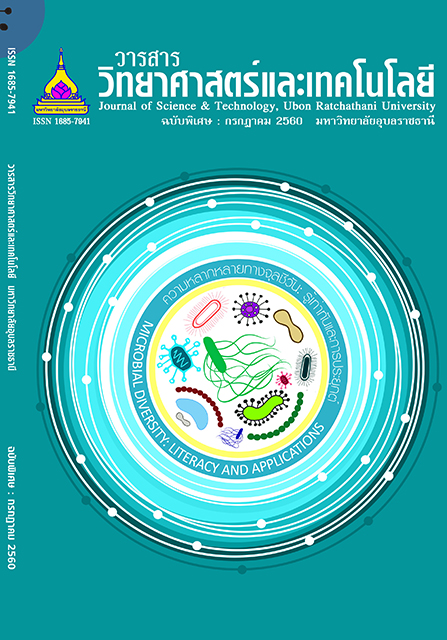ผลการต้านเชื้อราและการเสริมฤทธิ์กันของน้ำมันหอมระเหย จากพืชบางชนิดต่อเชื้อราที่ทำให้ผลิตผลทางการเกษตรเน่าเสีย
Main Article Content
บทคัดย่อ
บทคัดย่อ
การศึกษาผลของน้ำมันหอมระเหยจากว่านน้ำ (Acorus calamus) อบเชย (Cinnamomum zeylanicum) ว่านเต่าเกียด (Homalomena aromatica) เปราะหอม (Kaempferia galanga) และกานพลู (Syzygium aromaticum) ต่อยับยั้งการเจริญของเชื้อราที่ทำให้ผลิตผลทางการเกษตรเน่าเสีย ได้แก่ Alternaria alternata, Aspergillus niger, Fusarium moniliforme, Geotrichum candidum และ Rhizopus stolonifer ทำโดยใช้วิธี agar disc diffusion และการหาค่าความเข้มข้นต่ำสุด (MIC) ในการยับยั้งการเจริญ ปรากฏว่า น้ำมันอบเชยมีประสิทธิภาพในการยับยั้งการเจริญของเชื้อราได้ดีที่สุด เชื้อรา A. alternata, F. moniliforme และ G. candidum ไวต่อการถูกยับยั้งโดยน้ำมันอบเชยมากที่สุด (ค่า MIC เท่ากับ 0.125 มิลลิกรัมต่อมิลลิลิตร) รองลงมาเป็น A. niger และ R. stolonifer ซึ่งถูกยับยั้งได้ที่ค่า MIC เท่ากับ 0.25 มิลลิกรัมต่อมิลลิลิตร น้ำมันกานพลูและน้ำมันว่านเต่าเกียดมีประสิทธิภาพสูงในการต้านเชื้อราที่ทดสอบ แต่เชื้อราส่วนใหญ่ค่อนข้างต้านทานต่อการถูกยับยั้งโดยน้ำมันว่านน้ำและน้ำมันเปราะหอม ดังนั้นจึงได้คัดเลือกน้ำมันหอมระเหยจากอบเชย กานพลูและว่านเต่าเกียดมาศึกษาผลการเสริมฤทธิ์กันของน้ำมันคู่ผสมด้วยวิธี agar dilution checkerboard ผลปรากฏว่าน้ำมันคู่ผสมของ i) น้ำมันอบเชยกับน้ำมันว่านเต่าเกียดและ ii) น้ำมันกานพลูกับน้ำมันว่านเต่าเกียดให้ผลเสริมฤทธิ์กันในการยับยั้งการเจริญของเชื้อราส่วนใหญ่ที่ทดสอบโดยมีค่า fractional inhibitory concentration index ระหว่าง 0.56-0.73
คำสำคัญ: การยับยั้งการเจริญของเชื้อรา น้ำมันหอมระเหย การเสริมฤทธิ์
Abstract
The antifungal effects of mytle grass (Acorus calamus), cinnamon (Cinnamomum zeylanicum), colla aromatica Roxb. (Homalomena aromatica), aromatic ginger (Kaempferia galanga), and clove (Syzygium aromaticum) essential oils were studied on the agricultural produce spoilage molds Alternaria alternata, Aspergillus niger, Fusarium moniliforme, Geotrichum candidum, and Rhizopus stolonifer using the agar disc diffusion method and minimum inhibitory concentration determination (MIC). Cinnamon oil had the strongest antifungal activity. A. alternata, F. moniliforme and G. candidum were the most susceptible molds to cinnamon oil (0.125 mg/mL MIC), followed by A. niger and R. stolonifer (0.25 mg/mL MIC). Clove and colla aromatica Roxb. oils exhibited strong antifungal action, but most molds were relatively resistant to mytle grass and aromatic ginger oils. Therefore the oils of cinnamon, clove and colla aromatica Roxb. were selected to test for the synergistic effects of 2-oil combinations by the agar dilution checkerboard method. The results showed that the two oil combinations of cinnamon and colla aromatica Roxb. oils and clove and colla aromatica Roxb. oils had synergistic effects on most of the mold strains tested with a fractional inhibitory concentration index of 0.56-0.73.
Keywords: Antifungal activity: Essential oil: Synergism
Article Details
บทความที่ได้รับการตีพิมพ์เป็นลิขสิทธิ์ของ วารสารวิทยาศาสตร์และเทคโนโลยี มหาวิทยาลัยอุบลราชธานี
ข้อความที่ปรากฏในบทความแต่ละเรื่องในวารสารวิชาการเล่มนี้เป็นความคิดเห็นส่วนตัวของผู้เขียนแต่ละท่านไม่เกี่ยวข้องกับมหาวิทยาลัยอุบลราชธานี และคณาจารย์ท่านอื่นๆในมหาวิทยาลัยฯ แต่อย่างใด ความรับผิดชอบองค์ประกอบทั้งหมดของบทความแต่ละเรื่องเป็นของผู้เขียนแต่ละท่าน หากมีความผิดพลาดใดๆ ผู้เขียนแต่ละท่านจะรับผิดชอบบทความของตนเองแต่ผู้เดียว

